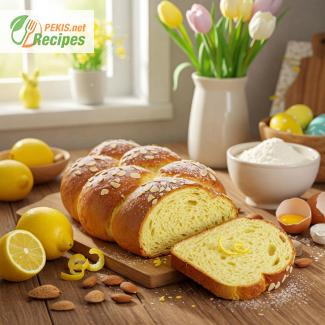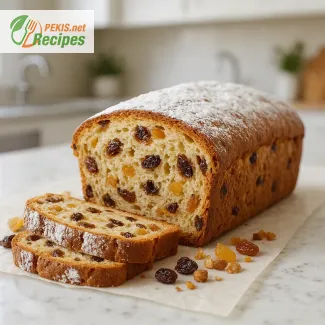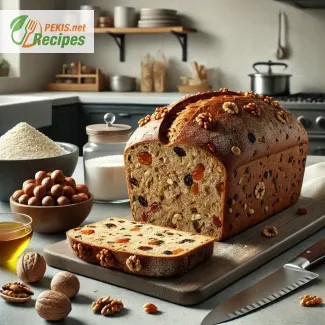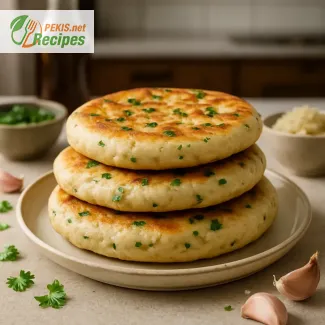
A Delicate Holiday Delight: Traditional Sweet Bread for Easter Gatherings
Soft, aromatic, and braided to perfection for festive spring mornings
There’s something undeniably heartwarming about the scent of freshly baked bread filling the kitchen on an early Easter morning. The sweet, citrusy aroma of lemon zest, the subtle crunch of toasted almonds, and the beautifully braided golden crust make this Easter bread not only a culinary centerpiece but a celebration of tradition, family, and renewal. This braided sweet Easter bread with lemon zest and almonds is more than just a seasonal treat—it's a cherished symbol of spring's arrival, carrying with it the warmth of home, heritage, and hospitality.
With roots in Central and Eastern European Easter customs, this soft, enriched dough has made its way into kitchens across the world, each version slightly different but equally beloved. What makes this particular bread exceptional is the harmony of zesty citrus, delicate sweetness, and the gentle crunch of sliced almonds, all wrapped into an intricate braid that’s as beautiful as it is delicious. The dough, enriched with eggs, butter, and sugar, rises into a pillowy texture, creating a bread that is light yet rich, making it perfect for brunches, breakfasts, or as a sweet companion to afternoon tea.
The cultural meaning behind braided Easter breads
Across many cultures, braided breads symbolize continuity, unity, and eternal life—concepts deeply tied to the themes of Easter. The interwoven strands reflect the intertwining of community and family, while the bread itself represents the blessing of abundance. Whether it’s known as Paska, Tsoureki, Kulich, or simply Easter loaf, the tradition of baking such breads is a moment of reflection and joy for many households.
In this version, lemon zest lifts the flavor with a refreshing brightness, cutting through the richness of the dough, while sliced almonds add a toasty depth and a satisfying texture. Sometimes a simple dusting of powdered sugar finishes it off, though some opt for a glaze made from lemon juice and sugar, enhancing the citrus notes and giving the bread a beautiful glossy finish.
Crafting the perfect dough for softness and flavor
At the heart of this Easter bread is the dough—soft, tender, and enriched just enough to yield a luxurious crumb without being too heavy. The inclusion of whole milk, eggs, and butter ensures richness, while active dry yeast guarantees a reliable rise. Sugar sweetens the base just slightly, ensuring the bread walks the fine line between being a dessert and a breakfast item.
The kneading process, whether done by hand or mixer, is key to achieving that smooth and elastic texture that ensures an even crumb and beautiful rise. After proofing, the dough is divided and braided—usually into three or six strands—resulting in a show-stopping appearance that's ideal for your Easter table.
The role of lemon zest and almonds in enhancing aroma and texture
While some traditional Easter breads focus on spices like anise or cardamom, this recipe highlights lemon zest, which brings a light and uplifting aroma that pairs perfectly with the bread’s tender interior. Fresh lemon zest not only perfumes the dough but also balances its sweetness, offering a citrus-forward note that feels just right for springtime.
Sliced almonds can be incorporated in two ways: some are folded directly into the dough, while others are sprinkled on top before baking. During the bake, they toast to a beautiful golden brown, releasing their nutty essence and adding a delicate crunch to each bite. This contrast in texture transforms the bread into something truly special—rich yet delicate, sweet but balanced.
A versatile centerpiece for your Easter table
This braided sweet bread is incredibly versatile. Serve it slightly warm with a pat of salted butter, pair it with fruit preserves or honey, or simply enjoy it as is, letting the flavors shine through. Leftovers (if there are any) can be transformed into French toast, or served lightly toasted with coffee or tea the next morning.
Its braided form makes it not only a treat to eat but also a visual masterpiece, turning your Easter spread into a feast for the eyes. Whether placed at the center of your brunch table or wrapped in a cloth and gifted to loved ones, this bread delivers comfort, nostalgia, and undeniable elegance.
A timeless tradition with room for personal flair
While this recipe offers a well-balanced, classic version, there is plenty of room for personal touches. You can infuse the dough with a splash of orange blossom water, replace almonds with pistachios or hazelnuts, or add raisins or dried cherries for a burst of sweetness inside the loaf. Some families add a dyed red egg in the center of the braid for symbolic effect, especially in Greek traditions, while others keep it minimal to showcase the golden crust.
Whether you follow the recipe to the letter or bring your own flair to the braid, this Easter bread is meant to be shared, savored, and remembered. Its soft texture, nuanced flavor, and stunning appearance make it a celebration of baking at its finest—a moment of quiet joy in the bustling season of spring festivities.
A celebration of the senses
The golden brown crust, the scent of lemon and almond wafting through the kitchen, the delicate layers revealed in every slice—this braided Easter bread is an experience meant for all the senses. It carries stories, memories, and a connection to generations of bakers before us, reinterpreted for today’s tables.
Whether you're continuing a long-standing tradition or starting a new one, this sweet, citrus-scented loaf offers more than nourishment—it offers meaning. As you prepare to gather with loved ones this spring, let this bread bring a sense of joy, renewal, and togetherness to your Easter celebration.
1. Activate the yeast:
Warm the milk (to about 37–40°C / 98–104°F) and stir in 1 tsp of the sugar. Add the dry yeast and let it rest for 10 minutes until it becomes frothy.
2. Mix the dough:
In a large mixing bowl, combine flour, sugar, salt, and lemon zest. Add the softened butter and mix using your fingers or a stand mixer fitted with the dough hook. Pour in the yeast mixture and crack in the eggs. Knead for about 10–12 minutes until the dough becomes smooth and elastic.
3. First rise:
Form the dough into a ball and place it in a lightly greased bowl. Cover with a clean towel and let it rise in a warm place for 1 to 1.5 hours, or until doubled in size.
4. Shaping the braid:
Punch down the risen dough and divide it into three equal parts. Roll each part into a long rope, about 40 cm (16 inches) long. Lay the ropes side by side and braid them gently, pinching the ends together. Transfer the braid onto a baking tray lined with parchment paper.
5. Second rise:
Cover the braided dough lightly with a kitchen towel and allow it to rise again for 30–40 minutes, or until slightly puffy.
6. Baking preparation:
Preheat the oven to 180°C (350°F). Beat the egg yolk and brush it over the braid for a golden shine. Sprinkle sliced almonds evenly on top.
7. Bake the bread:
Bake for 25–30 minutes until golden brown and fully cooked through. A skewer inserted into the center should come out clean.
8. Finishing:
Let the bread cool on a wire rack. Dust with powdered sugar if desired before serving.
Elevating the Classic: Creative Ways to Refine Your Easter Lemon Almond Bread
Small adjustments that bring out the best in flavor, texture, and presentation
A traditional braided Easter bread is already a beloved holiday staple—rich, soft, slightly sweet, and beautifully aromatic. However, even the most cherished recipes offer room for enhancement. Whether you're looking to personalize your bread, explore healthier substitutions, or simply avoid common pitfalls, there are thoughtful ways to improve the final result without losing the essence of this springtime favorite. Here’s how to take your braided sweet Easter bread with lemon zest and almonds from great to exceptional, ensuring a truly memorable bake every time.
The power of ingredient upgrades
Use higher-fat European-style butter
While regular unsalted butter works well, upgrading to European-style butter (with at least 82% butterfat) creates a richer, more tender crumb. The additional fat also intensifies the flavor, adding a luxurious mouthfeel that complements the bread’s sweet and citrusy profile.
Enhance with vanilla bean or orange blossom water
Infusing the dough with vanilla bean paste or a few drops of orange blossom water introduces floral and aromatic depth that pairs beautifully with lemon zest. These subtle additions enrich the bread’s flavor profile and evoke a more sophisticated sensory experience.
Replace white sugar with honey or maple syrup
Swapping part or all of the granulated sugar for honey or maple syrup adds complexity and moisture to the dough. Honey, in particular, gives the bread a gentle floral sweetness, while maple syrup offers an earthy warmth. These natural sweeteners can slightly deepen the bread’s golden crust and enhance shelf life.
Incorporate dried fruit or candied peel
Add chopped dried apricots, golden raisins, or candied orange peel into the dough for extra texture and natural sweetness. These ingredients offer delightful bursts of flavor throughout the bread and create a visual surprise in every slice.
Adjusting texture for improved softness and structure
Use tangzhong for a longer-lasting softness
The tangzhong method, where a small portion of flour is cooked with liquid into a roux, can be added to the dough to retain moisture and produce a pillowy, cloud-like texture. This method is particularly useful if you want the bread to stay fresh for multiple days.
Enrich the dough with extra yolk
If you're aiming for a denser and more indulgent bread, adding an extra egg yolk improves the dough’s structure and richness, giving the final loaf a more pronounced color and flavor.
Substitute part of the flour with almond flour
Replacing 10–15% of the wheat flour with almond flour not only complements the sliced almonds on top but also boosts the nutty flavor and increases the moisture retention of the bread. This results in a softer crumb and a longer-lasting loaf.
Homemade is best: why baking at home makes a difference
Nothing beats the flavor and texture of freshly baked homemade Easter bread. Commercial versions often contain preservatives, artificial flavors, or fillers to extend shelf life. At home, you have full control over ingredient quality, sweetness level, and texture. Moreover, homemade versions allow for customization that aligns with dietary preferences and personal tastes—something store-bought alternatives simply cannot match.
The act of preparing the dough, kneading by hand or with care, braiding, and watching the bread rise and bake offers not just culinary reward but also emotional satisfaction. It becomes an experience rooted in tradition, often shared with family, especially during the Easter season.
Avoiding common mistakes for a flawless loaf
Rushing the proofing process
Impatience during the rise stages is a common misstep. Insufficient proofing leads to dense or uneven bread, while over-proofing can cause the braid to collapse during baking. Ensure the dough has doubled in size but still holds shape—usually 60 to 90 minutes for the first rise, and 30 to 45 for the second.
Over-kneading or under-kneading
Under-kneading results in a weak gluten structure, leading to a flat or crumbly texture, while over-kneading can make the bread tough. Knead until the dough is smooth, elastic, and passes the windowpane test—a sign of ideal gluten development.
Ignoring temperature sensitivity
Milk that’s too hot can kill the yeast, while cold milk can slow the rise. Use a kitchen thermometer and aim for 37–40°C (98–104°F) for optimal yeast activation.
Applying egg wash too early
Brushing with egg wash before the final rise can deflate the dough. Instead, apply it just before baking to ensure a glossy, golden crust that doesn’t interfere with the bread’s structure.
Health-conscious alternatives without sacrificing flavor
Whole wheat blend
Using 30–40% whole wheat flour in place of all-purpose flour adds fiber and nutrients, though it may require slightly more moisture and a longer rise. To balance the heartier taste, consider increasing the lemon zest or sweetener slightly.
Dairy-free swaps
For a lactose-free version, replace whole milk with unsweetened almond or oat milk, and use plant-based butter. These alternatives still create a tender crumb while opening the recipe to those with dietary restrictions.
Egg substitutes
Vegans or those with egg allergies can use flaxseed eggs (1 tbsp ground flax + 3 tbsp water per egg) or unsweetened applesauce (¼ cup per egg). These substitutions help maintain moisture and binding, though the bread may be slightly denser.
Decorating variations that elevate presentation
Citrus glaze
A drizzle of lemon glaze (lemon juice and powdered sugar) after baking can enhance the bread’s brightness and add a glossy finish. It also helps almonds adhere and brings a bakery-quality look.
Colored sugar or pearl sugar
Instead of powdered sugar, decorative colored sugar or Scandinavian pearl sugar adds texture and a festive appearance without overwhelming the flavor.
Floral garnishes
Top the baked loaf with edible flowers or lemon zest curls for a spring-inspired visual that’s perfect for Easter brunch or gifting.
Improving a traditional recipe doesn't mean losing its soul—it means honoring it with attention and creativity. From ingredient enhancements and mindful techniques to aesthetic upgrades and healthier choices, there are countless ways to refine and elevate your braided sweet Easter bread while preserving the warmth and meaning behind it.
- Wheat (gluten)
- Eggs
- Milk
- Tree nuts (almonds)
Suggestions for allergen-free substitutions:
- Gluten-free option: Substitute wheat flour with a certified gluten-free 1:1 baking flour blend. Add 1 tsp xanthan gum if not included.
- Egg-free option: Replace each egg with 60 g (¼ cup) unsweetened applesauce or a flaxseed egg (1 tbsp ground flaxseed + 3 tbsp water).
- Dairy-free option: Use plant-based milk (e.g., almond or oat milk) and vegan butter.
- Nut-free option: Omit almonds or replace with toasted sunflower seeds or leave plain.
- Vitamin B1 (Thiamine): 0.2 mg – Supports energy metabolism and nerve function
- Vitamin B2 (Riboflavin): 0.15 mg – Aids in red blood cell production
- Vitamin B12: 0.4 µg – Essential for nerve function and red blood cell formation
- Vitamin D: 0.5 µg – Supports bone health and immune function
- Calcium: 40 mg – Contributes to bone strength
- Iron: 1.8 mg – Essential for oxygen transport in the blood
- Magnesium: 20 mg – Regulates muscle and nerve function
- Zinc: 0.8 mg – Supports the immune system and wound healing
- Vitamin E: 1.5 mg – Helps protect cells from oxidative stress
- Lutein + Zeaxanthin: 100 µg – Beneficial for eye health
- Beta-carotene: 250 µg – Converts to vitamin A and supports skin and vision
This recipe offers a beautiful harmony of flavor, aroma, and tradition—ideal for festive gatherings or as a homemade gift of love.





